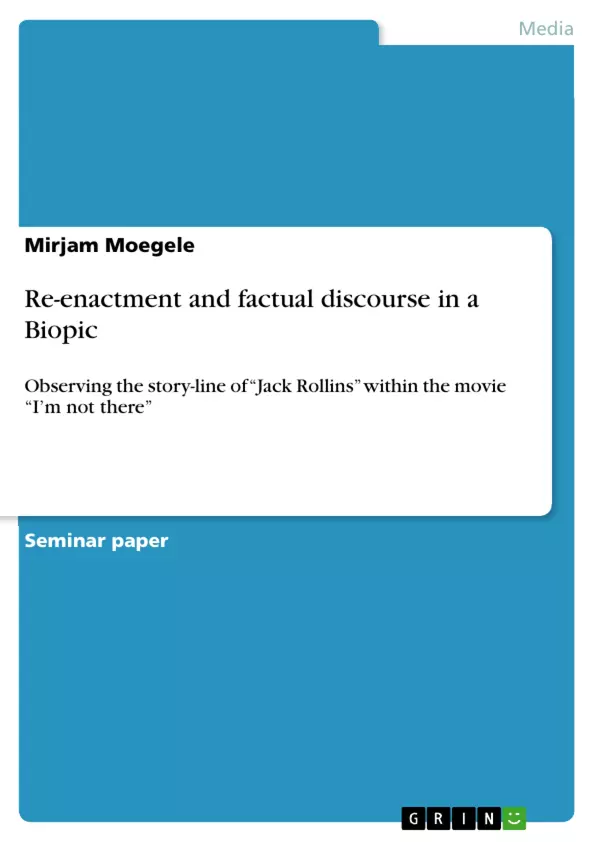In this essay I want to focus on the integration of “factual discourse” in its different forms in a movie and the effects they are creating for the viewer. First of all it is interesting to look, where we can situate the biographical movie within fiction and historical truthfulness. I want to show that re-enactment of originals and the application of fictional facts is animating the viewer to reflect differently on the represented images. Here it is interesting to observe the story-line of Jack Rollins, including the effects of aesthetics and documentary consciousness. The movie is playing to a huge account with aesthetics, but also with the cultural knowledge of people “knowing” something about Bob Dylan and the previous documentaries “Don’t look back” (cinema verite) and “No direction home”. It is interesting to observe how the viewer can actually differentiate between factual and fictional discourse and to which degree he might believe, what is presented to him. The question can also be framed into the whole aim of the movie, which might explain the choice of certain media techniques. In which ways is factual discourse integrated in the movie “I’m not there”? Which documentary techniques underline the purpose for authenticity? How does the movie play with the concept of “documentary consciousness”? What does the re-enactment of factual discourse and material together with fictional elements achieve compared to a classical documentary?
Table of Contents
- Placing the fictional biography “I'm not there” in context
- The various filming techniques, framework and story-lines in “I'm not there”
- The stories Woody Guthrie and Billy-the-Kid, which seem to represent the beginning and the end of the musician's life, apply Western movie techniques, the green and earthy colours reinforce the connection to nature and strong self-reflection.
Objectives and Key Themes
This essay aims to explore the integration of "factual discourse" in its various forms within the movie "I'm not there" and the effects it creates for the viewer. It investigates the movie's position between documentary and fiction, particularly in relation to the re-enactment of real events and the application of fictional elements. The essay examines how the use of different media techniques contributes to the blurring of boundaries between factual and fictional discourse.
- The interplay between factual and fictional discourse in biopics
- The role of re-enactment in creating authenticity and blurring the lines between reality and fiction
- The use of documentary techniques in a fictionalized biographical film
- The concept of "documentary consciousness" and its application in "I'm not there"
- The impact of aesthetics and narrative techniques on the viewer's perception of truthfulness.
Chapter Summaries
The first section explores the position of the movie "I'm not there" between documentary and fiction. It discusses the historical context of the film's release, including the rise of docudrama and the increasing blurring of boundaries between these genres in the late 20th century. The section then examines how the film utilizes documentary techniques and fictional elements to create a complex and layered narrative.
The second section delves into the various filming techniques, framework, and story-lines employed in "I'm not there." It analyzes how the use of different actors to represent the main character, Bob Dylan, creates distinct atmospheres and narrative perspectives within the film. The section also examines the impact of different visual styles, including black and white photography, seventies-style filming, and handheld camera techniques.
The third section focuses on the story-lines of Woody Guthrie and Billy-the-Kid, highlighting the use of Western movie techniques to create a sense of authenticity and connection to nature. It also examines the story-line of Jude Quinn and its use of black and white photography. The section concludes by briefly discussing the story-line of Robbie Clarke, emphasizing the integration of factual material from the Vietnam War.
Keywords
The main keywords and focus topics of this essay are: factual discourse, re-enactment, biopic, documentary consciousness, fiction, truthfulness, documentary techniques, aesthetics, narrative techniques, "I'm not there", Bob Dylan.
- Citation du texte
- Mirjam Moegele (Auteur), 2009, Re-enactment and factual discourse in a Biopic, Munich, GRIN Verlag, https://www.grin.com/document/147118



